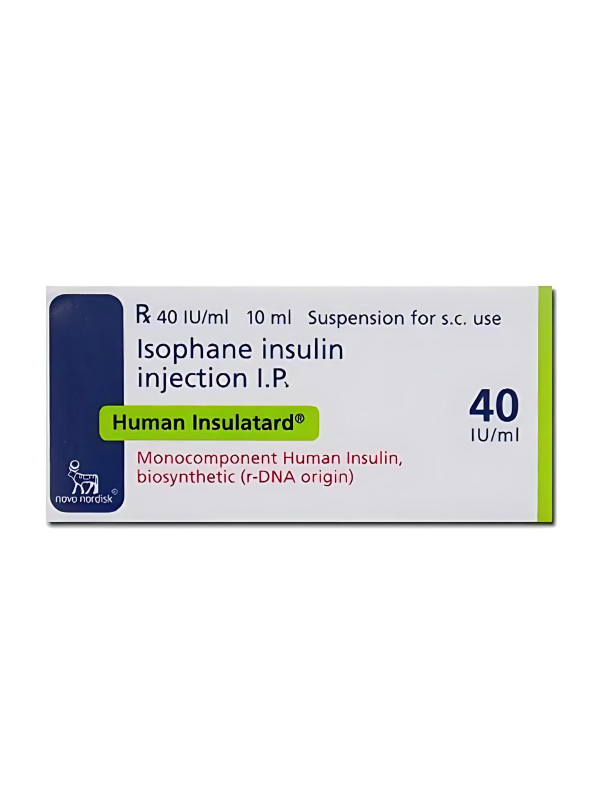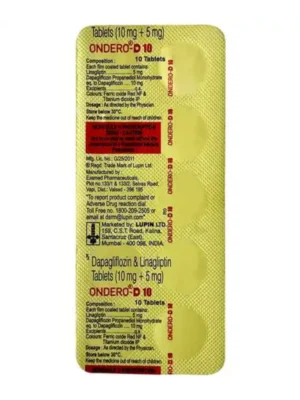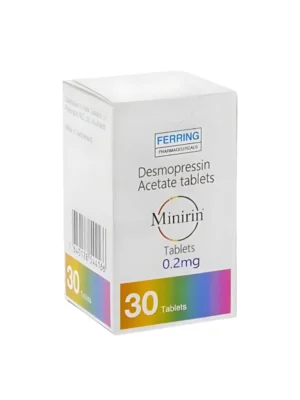Description
Human Insulatard Suspension for Injection (Biphasic Isophane Insulin) – Dual-Action Diabetes Treatment
Human Insulatard Suspension for Injection is a premixed insulin formulation combining intermediate-acting insulin isophane (NPH) with short-acting regular human insulin. This dual-action therapy provides both rapid onset and prolonged duration of blood sugar control, making it ideal for managing Type 1 and Type 2 Diabetes Mellitus in adults and children. Administered subcutaneously, it effectively mimics the body’s natural insulin response when used as part of a comprehensive treatment plan including diet control, exercise, and regular glucose monitoring. Patients must consume a carbohydrate-rich meal within 30 minutes post-injection to optimize glycemic control and prevent hypoglycemia.
Uses of Human Insulatard Suspension for Injection:
- Management of Type 1 Diabetes Mellitus (insulin-dependent)
- Treatment of Type 2 Diabetes when oral medications fail
- 24-hour blood glucose control with twice-daily dosing
Benefits of Human Insulatard Suspension for Injection:
This biphasic insulin offers convenient blood sugar management by combining rapid meal-time coverage with sustained basal control. The premixed ratio (typically 70% isophane/30% regular) reduces injection frequency while maintaining stable glucose levels. Clinical studies demonstrate reduced risks of long-term diabetic complications including retinopathy, nephropathy, and neuropathy when optimal glycemic control is achieved.
Side Effects of Human Insulatard Suspension for Injection:
- Very common: Hypoglycemia (sweating, tremors, confusion)
- Common: Injection site reactions (pain, erythema, lipodystrophy)
- Occasional: Weight gain, allergic skin reactions, peripheral edema
How to Use Human Insulatard Suspension for Injection?
- Gently roll the vial to resuspend before drawing dose
- Inject subcutaneously in abdomen, thighs, or upper arms
- Rotate injection sites to prevent lipohypertrophy
- Administer 30 minutes before meals containing carbohydrates
- Unopened vials: Refrigerate at 2-8°C
- In-use vials: Store at room temperature (≤25°C) for ≤6 weeks
How Human Insulatard Suspension for Injection Works?
The regular insulin component provides rapid onset (30-60 minutes) to control postprandial spikes, while isophane insulin delivers intermediate action (peak 4-12 hours) for sustained basal coverage. Together they facilitate cellular glucose uptake in peripheral tissues while suppressing hepatic gluconeogenesis, mimicking physiological insulin secretion patterns.
Safety Advice:
- Alcohol: Absolutely avoid – potentiates hypoglycemia
- Pregnancy: Safe with medical supervision (dose adjustments likely)
- Breastfeeding: Compatible – minimal transfer to breastmilk
- Driving: Test blood sugar before operating vehicles/machinery
- Renal/Hepatic Impairment: Requires dose reduction & frequent monitoring
What If You Missed a Dose?
Check blood glucose immediately. For hyperglycemia (>200 mg/dL), administer 50% of missed dose and monitor closely. Never double dose to compensate. Maintain consistent meal timing to prevent glycemic fluctuations.
FAQs:
Q1: How should I mix Human Insulatard properly?
Gently roll the vial 10 times (don’t shake) until the suspension appears uniformly cloudy. Inspect for clumping or discoloration before use.
Q2: Can I switch from other insulin to Human Insulatard?
Transition requires medical supervision. Dose ratios differ significantly between insulin types – consult your doctor for proper conversion protocols.
Q3: Why must I eat within 30 minutes after injection?
The regular insulin component begins working within 30 minutes. Delaying meals risks dangerous hypoglycemia as glucose absorption can’t match insulin activity.
Q4: How do I recognize severe hypoglycemia?
Symptoms progress from sweating/confusion to seizures/loss of consciousness. Treat immediately with oral glucose (15-20g) or glucagon injection if unconscious.
Q5: What’s the best injection site rotation pattern?
Systematically rotate between abdominal quadrants, thighs, and upper arms. Track sites to avoid repeating within 1-inch radius for ≥1 month.
Q6: Can I use expired Human Insulatard?
Never use expired insulin. Altered potency may cause uncontrolled hyperglycemia or unexpected hypoglycemia from degraded components.
Q7: How often should I check my blood sugar?
Minimum 4x daily (fasting + postprandial). More frequent monitoring needed when adjusting doses, during illness, or if hypoglycemia occurs.








There are no reviews yet.